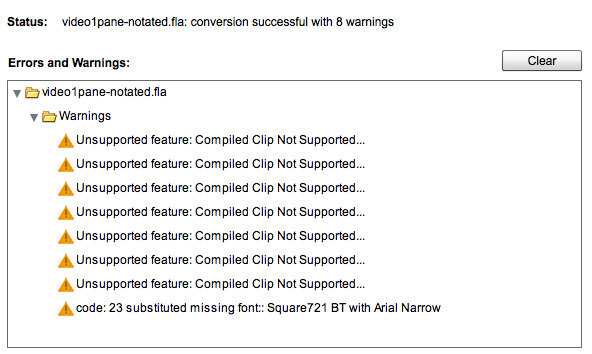Adobe Wallaby is No Magic Bullet for Flash-to-HTML5 Conversion
Lost in the hoopla last October, when Adobe telegraphed its intent to play nice with HTML5 during the Adobe MAX conference, was a sneak peak demonstration of a Flash-to-HTML5 converter, codenamed Wallaby.
Last week, the preview version of Wallaby was posted on Adobe Labs, along with the disclaimer that is indeed a technology preview (meaning it's not very stable or well-documented) and the further news that it may never see full public release as a standalone or integrated product.
We took Wallaby for a spin, using Preview 1 on the Mac to see what it's capable of.
Before we talk about our results, however, let's talk about what tasks Wallaby is intended to perform, and which ones it won't do.
Adobe calls Wallaby "an experimental technology that converts the artwork and animation contained in Adobe Flash Professional into HTML" code.
The key piece of information here is that a user must either have Flash Professional loaded on his machine, or must have access to the FLA file-the file that Flash designers and programmers use to create the output file most non-designers associate with Flash (that one's called the SWF).
If you're familiar with Photoshop, the FLA file is equivalent to Photoshop's PSD file format, which houses all the layers and effects. The SWF, on the other hand, would be equivalent to the JPEG or PNG that Photoshop outputs for web viewing. Just like Photoshop flattens a PNG file, stripping away the layers, when outputting content for the web, so too Flash strips away all but the basic information in a SWF file.
Using Wallaby hand-in-hand with the FLA and Flash Professional, then, makes sense, as there are a number of Flash settings that don't translate well into HTML5.
Why go to the trouble of converting and troubleshooting the conversion? Well, there are several tens of millions of iOS devices that don't have any Flash Player capabilities (Flash Player is the browser plug-in that plays SWF files; the plug-in's name is often shortened to "Flash" but we'll use the Flash Player designation to avoid any potential confusion).
Adobe states as much on Adobe Labs, but a bit more diplomatically.
"Wallaby allows you to reuse and extend the reach of your content to devices that do not support the Flash runtimes," the company states. "Once these files are converted to HTML, you can edit them with an HTML editing tool, such as Adobe Dreamweaver, or by hand if desired. You can view the output in one of the supported browsers or on an iOS device."
If you're wondering what all this has to do with online video, the key thing to remember is that Wallaby does not convert video files but it does have the potential to convert the players around video files.
Flash video has traditionally required a SWF-based video player in which to receive the Flash video stream. While Wallaby doesn't change the need for a video player to play the Flash streaming content sent from Flash Media Server, it does allow a developer to maintain a consistent look-and-feel between Flash video played back in Flash Player and more "traditional" MP4/H.264 video played back on an iOS device.
To that end, we tested the conversion of a Flash-based video player that had been created for a project back in 2006. Our intent was to create an HTML5-compliant video player that had the same look and feel, using Wallaby to convert the FLA file.
The interface for Wallaby is straightforward: pick the FLA file that you want to convert, then choose a location to output the file, and click the "convert" button.
Our first attempt to load up the FLA and convert it resulted in a very generic error: FLA File Version Not Supported.
When we asked Adobe about this error, we were told that our test FLA file was too old.
"Wallaby only works with Flash Professional CS5 files at this time," an Adobe spokesperson stated. "If you have older FLA files (CS3 or CS4) you need to resave them with Flash Professional CS5. Wallaby is a technology preview and as such it has certain limitations that would not exist in a final product."
In other words, it might work with CS3 or CS4, if Wallaby becomes a product, but isn't guaranteed to do so.
After we updated the file in Flash Professional CS5, we were able to run the conversion.
It wasn't perfect by any means, and it generated a number of errors for compiled, tweening and certain filters-a list of the supported features in this first technology preview can be found in the Wallaby release notes-but the conversion did provide enough of the framework around the video player that we could manipulate the outcome by hand coding.

It might have also been possible to use Dreamweaver's graphic interface, but we've recently updated our version to include the HTML5 pack, so we were uncertain whether this would be a standard set up for most users.
We tested another, more recent file with similar results: not perfect, but good enough. Our conclusion is that Wallaby has potential to keep designers and developers from having to start over completely from scratch.
Will it eliminate the need to churn out HTML code? No, especially for those with complex FLA files, but this may change with follow-on technology preview versions.
Speaking of additional previews, there's plenty of time to try out the technology-and offer feedback-before Adobe determines whether Wallaby will be an actual product.
"Wallaby is not a final product and is still in the testing and validation phase," the spokesperson stated. "As Adobe is inviting user feedback about the technology to help create the best possible product, we cannot commit to a roadmap at this time."
Related Articles
New hosted service acts as a virtual service provider for content owners and cable MSOs.
23 Mar 2011